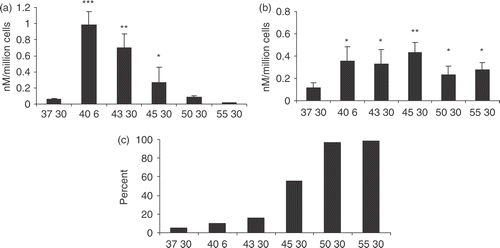Figures & data
Figure 1. HSP70 release from prostate carcinoma cells at 40°C and 43°C. HSP70 release following heat shock treatment. 1 × 106 cells per ml PC-3 (a and c) and LNCaP (b and d) cells were incubated at 37°C control group represented by 37 or non-heat shocked cells, 40°C for 6 h represented by 40, and 43°C for 30 min represented by 43. (a) (PC-3) and (b) (LNCaP) represent HSP70 release immediately after heat shock while (c) (PC-3) and (d) (LNCaP) represent HSP70 released 24 h after heat shock. Supernatants were taken and analysed for the presence of HSP70 by ELISA. Statistical analyses compared conditions 37 vs. 43 (*p < 0.05) (a) and 37 vs. 40 (a) and 37 vs. 43 (b) (**p < 0.01) and 37 vs. 40 (***p < 0.001) (b). Data represents the mean ± SD of three independent experiments.
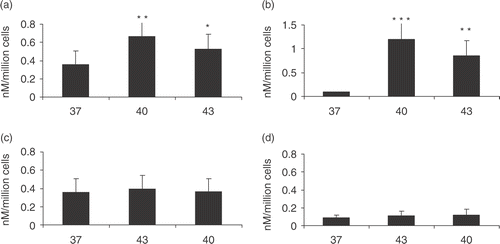
Figure 2. Effect of exposure to MG-132 on HSP70 release. 1 × 106 cells per ml PC-3 (a) and LNCaP (b) cells were incubated with 0.5 and 5 µM of MG132 (0.5 and 5, respectively) or no treatment with MG132 (43) followed by heat treatment at 43°C for 30 min. The control group was not treated with heat nor MG132. Supernatants were taken and analysed for the presence of HSP70 by ELISA. Statistical analyses compared conditions MG132 0.05 μM vs. 43 30 (*p < 0.05) in (a) and (b); while MG132 5 µM vs. 43 30 (**p < 0.01) in (a) and (b). Data represents the mean ± SD of three independent experiments.
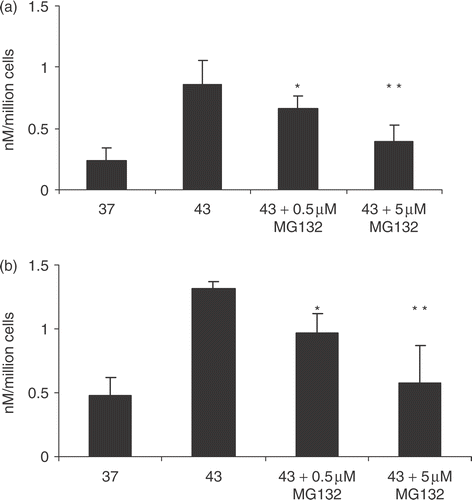
Figure 3. HSP70 release in thermotolerant cells. PC3 (a) and LNCaP (b) cells were heat shocked at indicated temperatures and 24 h later the supernatants were discarded and fresh media was added followed by a second heat shock at the indicated temperatures. The supernatants were harvested immediately after the second heat shock and analysed for HSP70 release. 43/43 represents 1st heat shock at 43°C for 30 min followed by a second heat shock 24 h later at 43°C for 30 min; 40/40 represents 1st heat shock at 40°C for 6 h followed by a second heat shock 24 h later at 40°C for 6 h and 43/40 represents 1st heat shock at 4°C for 30 min followed by a second heat shock 24 h later at 40°C for 6 h. Supernatants were taken and analysed for the presence of HSP70 by ELISA. Statistical analyses compared conditions 37 vs. 40/40(*p < 0.05) and 37 vs. 43/43 and 43/40(**p < 0.01) in (a); while 37 vs. 43/43 and 43/40 (*p < 0.05) and 37 vs. 40/40 (**p < 0.01) in (b). There were statistical significance observed when comparing 40 (Figure 1) vs. 40/40 (Figure 3) (**p < 0.01) for the LNCaP cells; 40 (Figure 1) vs. 40/40 (Figure 3) in the PC3 cell group and 43 (Figure 1) vs. 43/43 (Figure 3) in the LNCap cell group (*p < 0.05). Data represents the mean ± SD of three independent experiments.
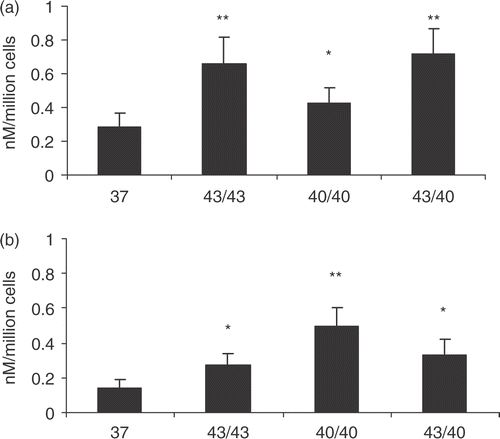
Figure 4. HSP70 release and trypan blue uptake in PC-3 cells exposed to temperatures from 37–55°C. PC3 cells were heat treatments at 37°C, 43°C, 45°C, 50°C and 55°C for 30 min and 40°C for 6 h. Supernatants were harvested immediately after the heat treatment (a) and 24 h after the heat treatment (b) and tested for the presence of HSP70 by ELISA. Trypan blue uptake, 4C, was analysed 24 h after the heat treatments. Statistical analyses compared 37 vs. 45 and 37 vs. 43 (a) 37 vs. 43, 50, 55 (b) (*p < 0.05); 37 vs. 43 (a) and 37 vs. 45 (b) (**p < 0.01); 37 vs. 40 (a) (***p < 0.001). Data represents the mean ± SD of three experiments done in triplicate.
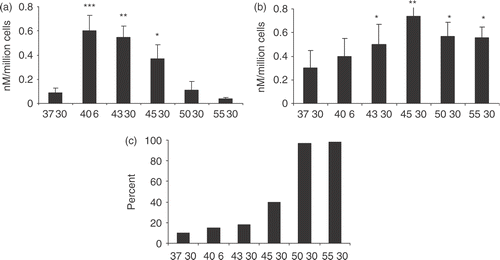
Figure 5. HSP70 release and trypan blue uptake in LNCaP cells exposed to temperatures from 37–55°C. LNCaP cells were heat treated as described in Figure 4 and supernatants were harvested immediately after the heat treatment (a) and 24 h after the heat treatment (b) and tested for the presence of HSP70 by ELISA. Trypan blue uptake, 5C, was analysed 24 h after the heat treatments. Statistical analyses compared 37 vs. 45 (a) and 37 vs. 40, 43, 50, 55 (b) (*p < 0.05); 37 vs. 43 (a) and 37 vs. 45 (b) (**p < 0.01); 37 vs. 40 (a) (***p < 0.001). Data represents the mean ± SD of three experiments done in triplicate.
